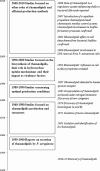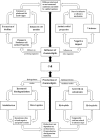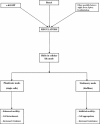Why do microorganisms produce rhamnolipids?
- PMID: 22347773
- PMCID: PMC3270259
- DOI: 10.1007/s11274-011-0854-8
Why do microorganisms produce rhamnolipids?
Abstract
We review the environmental role of rhamnolipids in terms of microbial life and activity. A large number of previous research supports the idea that these glycolipids mediate the uptake of hydrophobic substrates by bacterial cells. This feature might be of highest priority for bioremediation of spilled hydrocarbons. However, current evidence confirms that rhamnolipids primarily play a role in surface-associated modes of bacterial motility and are involved in biofilm development. This might be an explanation why no direct pattern of hydrocarbon degradation was often observed after rhamnolipids supplementation. This review gives insight into the current state of knowledge on how rhamnolipids operate in the microbial world.
Figures
Similar articles
-
Physicochemical interactions between rhamnolipids and Pseudomonas aeruginosa biofilm layers.Environ Sci Technol. 2015 Mar 17;49(6):3718-26. doi: 10.1021/es505803c. Epub 2015 Feb 26. Environ Sci Technol. 2015. PMID: 25668444
-
Effects of rhamnolipids on cell surface hydrophobicity of PAH degrading bacteria and the biodegradation of phenanthrene.Bioresour Technol. 2011 Mar;102(5):3999-4007. doi: 10.1016/j.biortech.2010.11.088. Epub 2010 Nov 25. Bioresour Technol. 2011. PMID: 21208798
-
Rhamnolipids mediate detachment of Pseudomonas aeruginosa from biofilms.Mol Microbiol. 2005 Sep;57(5):1210-23. doi: 10.1111/j.1365-2958.2005.04743.x. Mol Microbiol. 2005. PMID: 16101996
-
The involvement of rhamnolipids in microbial cell adhesion and biofilm development - an approach for control?Lett Appl Microbiol. 2014 May;58(5):447-53. doi: 10.1111/lam.12211. Epub 2014 Jan 24. Lett Appl Microbiol. 2014. PMID: 24372465 Review.
-
Quorum sensing: implications on rhamnolipid biosurfactant production.Biotechnol Genet Eng Rev. 2010;27:159-84. doi: 10.1080/02648725.2010.10648149. Biotechnol Genet Eng Rev. 2010. PMID: 21415897 Review.
Cited by
-
Rhamnolipids as a Tool for Eradication of Trichosporon cutaneum Biofilm.Biomolecules. 2021 Nov 19;11(11):1727. doi: 10.3390/biom11111727. Biomolecules. 2021. PMID: 34827725 Free PMC article.
-
Corner Flows Induced by Surfactant-Producing Bacteria Bacillus subtilis and Pseudomonas fluorescens.Microbiol Spectr. 2022 Oct 26;10(5):e0323322. doi: 10.1128/spectrum.03233-22. Epub 2022 Oct 10. Microbiol Spectr. 2022. PMID: 36214703 Free PMC article.
-
Treatment of Pseudomonas aeruginosa infectious biofilms: Challenges and strategies.Front Microbiol. 2022 Aug 26;13:955286. doi: 10.3389/fmicb.2022.955286. eCollection 2022. Front Microbiol. 2022. PMID: 36090087 Free PMC article. Review.
-
Rhamnolipids elicit defense responses and induce disease resistance against biotrophic, hemibiotrophic, and necrotrophic pathogens that require different signaling pathways in Arabidopsis and highlight a central role for salicylic acid.Plant Physiol. 2012 Nov;160(3):1630-41. doi: 10.1104/pp.112.201913. Epub 2012 Sep 11. Plant Physiol. 2012. PMID: 22968829 Free PMC article.
-
Aided Phytoremediation to Clean Up Dioxins/Furans-Aged Contaminated Soil: correlation between microbial communities and pollutant dissipation.Microorganisms. 2019 Nov 3;7(11):523. doi: 10.3390/microorganisms7110523. Microorganisms. 2019. PMID: 31684182 Free PMC article.
References
-
- Al-Tahhan RA, Sandrin TR, Bodour AA, Maier RM. Rhamnolipid-induced removal of lipopolysaccharide from Pseudomonas aeruginosa: effect on cell surface properties and interaction with hydrophobic substrates. Appl Environ Microbiol. 2000;66:3262–3268. doi: 10.1128/AEM.66.8.3262-3268.2000. - DOI - PMC - PubMed
-
- Arino S, Marchal R, Vandecasteele JP. Identification and production of a rhamnolipidic biosurfactant by a Pseudomonas species. Appl Microbiol Biotechnol. 1996;45:162–168. doi: 10.1007/s002530050665. - DOI
Publication types
MeSH terms
Substances
LinkOut - more resources
Full Text Sources




